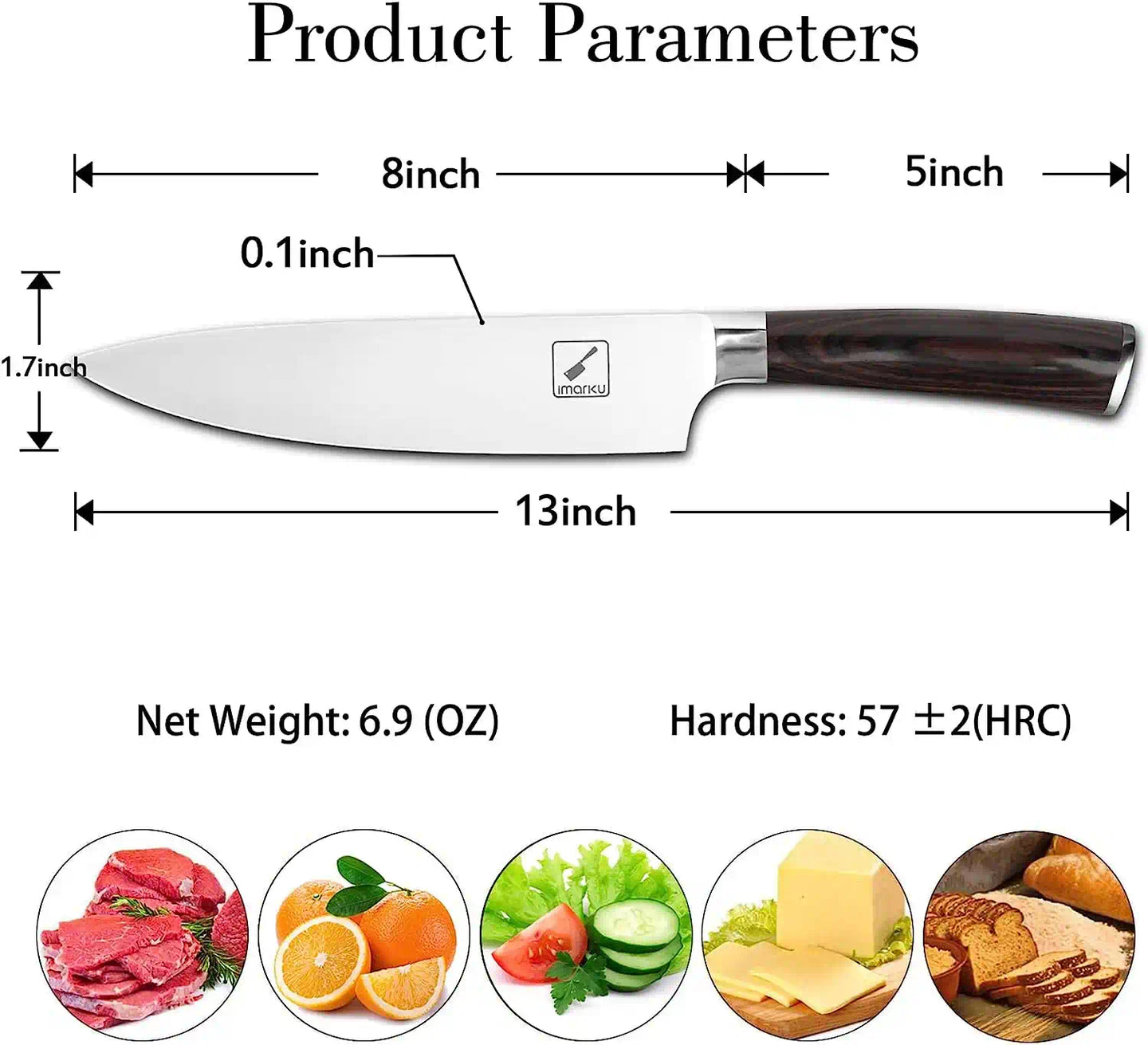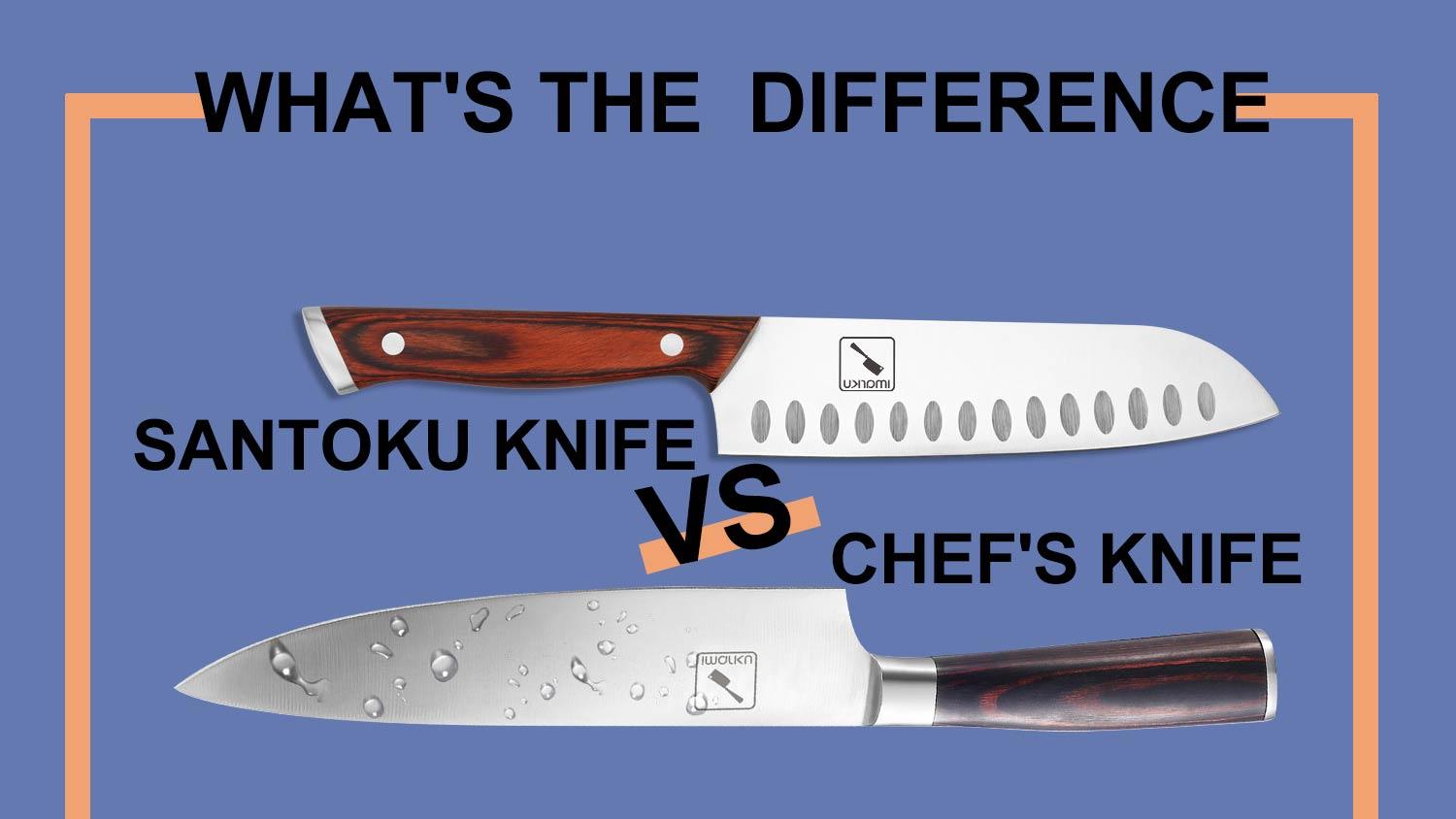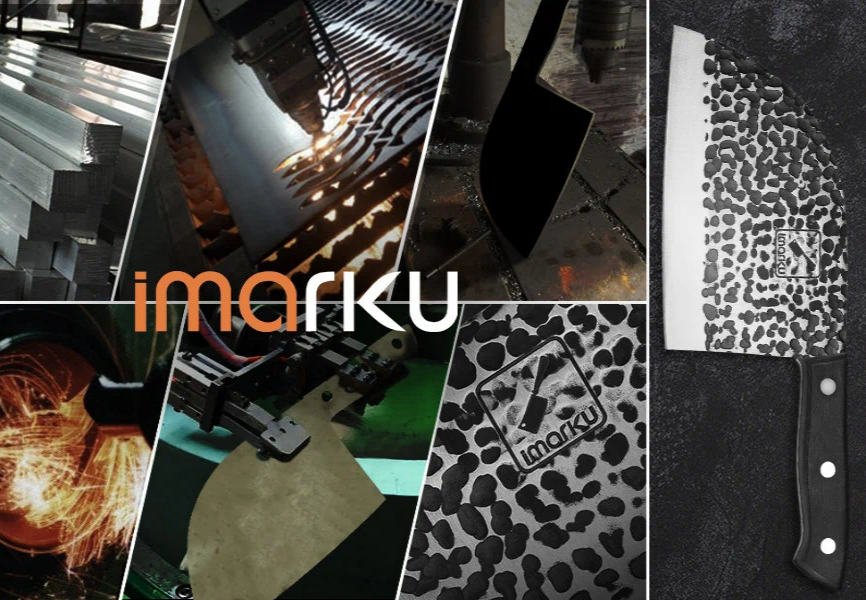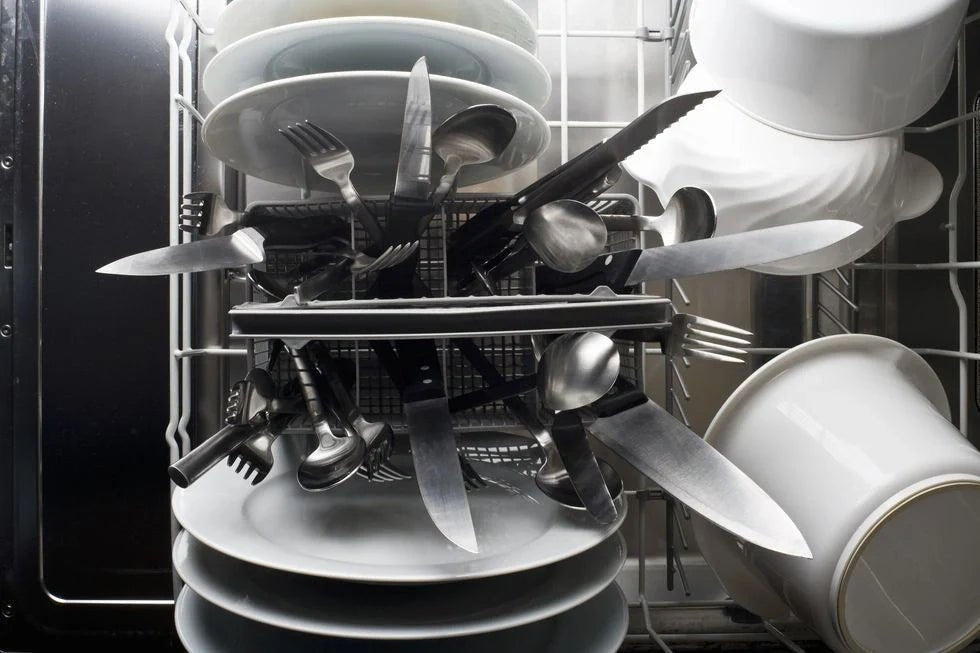TABLE OF CONTENTS
Many experienced chefs use chef's knives and santoku knives because they are adaptable enough to execute various jobs in the kitchen. Santoku knives being technically a kind of chef's knife. However, they differ in shape and style from classic French and German blades.
The difference between a santoku knife and a chef's knife would be that santoku knife is best suited to precision cutting, where very thin cuts are required. With a chef's knife, achieving the same level of precision is more difficult.
Santoku knives also demand a unique method, slicing through all the food in a front and backward motion rather than rocking back and forth movement as a typical chef's knife does.
Bear in mind the chef's knives come in a variety of styles. Let's get to know more detailed differences between them.

What’s a Santoku?
The Santoku knife is a relatively new Japanese chef's knife, invented in the mid-20th century. Santoku knives are general purpose kitchen knives that are good for slicing meat, fish and vegetables as they have a straight and short blade.
This knife was developed from the rectangular blade of the traditional Japanese vegetable knife.
Traditionally, Japanese chefs use Gyuto knives for meat, Deba knives for fish, and Nakiri knives for vegetables. Because all three can cut, it is called "three virtues" knife, that is, the knife can cut, cut, and chop.
How to Use a Santoku?
To use a Santoku knife effectively, start by gripping the handle firmly with one hand and placing your fingers on the blade's spine for stability. Use a rocking motion to slice through ingredients, ensuring the tip of the knife remains on the cutting board while your hand guides the blade.
The Santoku's sharpness makes it ideal for precise chopping, dicing, and slicing tasks, providing seamless kitchen performance. Regular sharpening and proper maintenance ensure consistent, efficient usage.
How to Maintain a Santoku Knife's Performance?
To maintain your Santoku knife's longevity and performance, hand wash it with mild soap and warm water, avoiding dishwashers. Dry it immediately after washing to prevent corrosion.
Store it in a knife block or on a magnetic strip to protect the edge, and regularly hone the blade for sharpness. Avoid cutting bones or hard surfaces to prevent chipping.
The Pros and Cons of Santoku Knives
Pros:
Lightweight – Santoku are generally lighter than Western chef’s knives, which some chefs prefer as they find the lightweight knife easier to use.
Precise - This knife is great for precise cutting, so it's great for dicing or slicing vegetables.
Control - Japanese knives are only sharpened on one side, which gives the cook more control over the knife.
Narrow Blades - Japanese knives have narrower blades than Western knives, so they can create thinner cuts.
Speed - Santoku knives cut faster because they are harder, thinner, and don't require a rocking motion.
Easy to sharpen - These knives usually don't have shims, which means they're easier to sharpen.
Edge retention - Japanese knives usually have a sharper blade that will hold an edge longer.
Cons:
Less Finger Protection - While the lack of support pads means you can sharpen the blade more easily, it's also a downside. Since there are no support pads, there is no way to prevent your fingers from slipping on the blade.
Too Flexible - The flexibility of these knives means they are not suitable for many tough jobs, such as carving meat or carving tough vegetables.
Can a Santoku knife replace a Chef's knife?
While both are utility knives, there are some differences when it comes to cutting tasks. The Santoku can be used for very thin slices, ideal for chopping vegetables, chopping onions, etc. for small size ingredients.
On the other hand, if you're dealing with meat that needs to be separated, such as a whole chicken wing, a chef's knife might be a better choice.
What’s a Chef’s Knife?
A chef's knife is a versatile, multi-purpose knife that serves multiple functions. It has a sharp, broad blade. Its sturdy and slightly curved body complements this perfectly.
Measuring between 6 and 12 inches, these knives are ideal for a variety of functions including (but not limited to) mincing, slicing, or mincing meat and vegetables, mincing meat and vegetables, thinly slicing, chopping vegetables and herbs Shredded and diced nuts.
The defining element of these knives is their sharp edges, often with a beveled and curved design. The curve is especially important as it allows the chef to have the perfect rocking motion when chopping meat, vegetables or nuts.
How to Use a Chef Knife?
To use a chef knife effectively, start with a firm grip on the handle and a secure hold on the item you're cutting. Use a rocking motion, pivoting the knife on the cutting board, to chop or mince.
For slicing, use a gentle back-and-forth motion. Keep fingers tucked in and use a claw-like grip to guide the knife. Practice proper cutting techniques to ensure precision and safety in the kitchen.
How to Care for a Chef Knife?
To care for a chef knife, it's crucial to clean it immediately after use with warm, soapy water, avoiding abrasive sponges to prevent damage. Regularly hone the blade to maintain sharpness and store it in a knife block or magnetic strip.
Hand wash and dry thoroughly to prevent rust, and occasionally oil the blade for longevity and smooth performance.
Santoku Knife VS Chef's Knife Components (Side-by-side comparison)

Image from heathykitchen101.
Santoku vs Chef's Knife, What's The Difference
Style and Performance
For most chefs, the most important qualities of a knife are its style and performance. The term "style" has to do with the shape and design of the knife, while "performance" has to do with how sharp it is and how it performs in use.
Santoku Knife

The lightweight, narrow blade of the Santoku knife is ideal for precision work as it cuts smaller slices because less food needs to be pushed away as the blade cuts each slice.
Japanese knives cut food in a back and forth motion, while Western knives require a rocking motion, which can cut thicker slices and take longer to cut food than faster Santoku blades.
Chef’s knife
Typical of German and French knives is a straight edge with a slight curvature from root to tip. In terms of performance, the biggest benefit over chef's knives like Mio's is that these chef's blades are strong enough to cut through meat, fruit, fish, and vegetables.

The thin sheep's toes and flexible blades of Santoku knives make them unsuitable for more demanding tasks such as boning. The stronger steel of Santoku blades makes them easier to chip.
The same method is used for cutting difficult vegetables such as radishes and butternut squash. Chef's knives are the ultimate all-purpose knives for a variety of food preparation tasks for many professionals and home cooks.

Blade Length
Compared to chef's knives, santoku knives have a shorter blade, about 6 inches in length. The shorter blade allows for more control, which is especially beneficial for less experienced cooks.
Chef blades are usually 8 inches long, but can be as long as 14 inches.
Imarku's Chef's Knife 8" and Santoku Knife 7" are the best chef knives and santoku knives. These knives are made of high carbon stainless steel blades, ultra-sharp edges, and an ergonomic handle. The santoku knives are professional with an ultra-sharp edge, hollow edge design with ergonomic design.
Blade Material
Most kitchen blades use stainless steel. However, the type and finish of the steel used varies from manufacturer to manufacturer. Western knives have thicker blades made of softer but harder steel. The delicacy of the steel means that the blade needs to be sharpened more often.
Chef's knives are less prone to chipping due to the softness of the steel blade. The hardness of the blades can make them appear heavy, which may not be a good or bad quality of the knife depending on the particular preference.
Knife Handle
The bolster is an important part of the handle of a German or French knife and is not usually found on traditional Santoku knives. Anyone new to professional knives may benefit from choosing a blade with this backing pad. It helps keep hands from slipping off the blade and provides extra grip. Both knives usually have full tangs, giving a sense of balance.
The Pros and Cons of Chef's Knives
Pros:
Sturdy and Versatile - In many ways, chef's knives are more versatile than santoku knives because you can use them for precise and tough jobs. They easily cut through vegetables, meat or fish.
Durable - A chef's knife is more durable due to the material it is made of. They are softer than Japanese knives, so they are less prone to chipping. They are usually made of stain and rust resistant materials.
Bolster - Unlike the Santoku, the Chef's Knife has a pad, this protects the fingers as it prevents them from slipping onto the blade.
Better Grip - The design of chef's knife handles means they generally have a better grip than Japanese knives.
Cons:
Lack of Control - While the long blade is an advantage for carving larger ingredients, it also makes the knife difficult to control.
Sharper - The softer metals used for chef's knives mean they need to be sharpened more often.
Santoku vs. Chef's Knife Sharpening

Santoku Knife Sharpening
Many Santoku knives are a cross of West and East, although the blades are curved, have flat cutting edges, and are sharpened 50/50 on both sides. Use standard steel or pull through the sharpener, which makes sharpening and maintenance easy.
When sharpening the Santoku Knife, hold the knife in your dominant hand with the tip facing forward, keeping the remaining hand and forearm as rigid as possible. It is best to use a rocking motion if the knife is held flat on the whetstone.
With each stroke, you should move the knife back and forth, not up and down, or even in a circular motion.
If the knife is too blunt, use the honing steel at a 45 to 60 degree angle and run it in short strokes up and down or in a circular motion.
For good results, the stone should be between 600 and 1000 grit.
Stones used to sharpen santoku knives are usually around 600 grit to keep the edge sharp.
Chef's Knife Sharpening
The best way to sharpen these chef's knives is with the hon method. This sharpening mechanism involves using a proper honing rod and sharpening with a whetstone.
In addition to using honing sticks and whetstones, experts suggest that you can also choose an electric sharpener. They're the best choice for your sharpening needs, but they won't achieve similar sharpness or precision to manual sharpening results.
If the sharpening requirements are met, you can enhance the functionality of your knives with the sharpening described above. However, if they are not available or you are unsure of the proper sharpening process, you can seek the services of a professional sharpener. These guys have the proper skills and the right equipment to sharpen knives and get a precise cutting edge.
Imarku 7-Inch Sankotu Knife
The imarku 7 inch Sankotu Knife is high quality stainless steel that will not rust, corrode or even tarnish.
High-quality metal also keeps the blade sharp for a long time. You don't need to sharpen your iMarku 7" very often, nor do you need to sharpen it professionally. It is capable of many intricate cuts that only a very sharp knife can make.
Like the iMarku 5-inch, the 7-inch is designed with a hollow edge to ensure the space between the food and the knife edge. This prevents food from sticking to the blade, which is why iMarku knives are worth buying.
The size and shape of the handle is just right for a knife of this size. Even if your hands are small, the handle fits just right. Thanks to its ergonomic design, you can cut for long periods of time without getting tired.
Imarku 8-inch Chef’s Knife
The imarku 8-inch Classic Chef’s Knife is essential for preparing any meal.
High Carbon Stainless Steel Blade
It is made of 7cr17MoV steel to maintain its function for a long time. The steel contains 0.6-0.75 carbon to increase its sturdiness. This makes it twice as hard as similar knives, since they contain about 0.3% carbon. And the steel hardness is above 60 HRC (much better than ZWILLING PROFESSIONAL S $159.99 each - 55-58 HRC).
Walnut Finish, Pakkawood Handle
To make it more professional and to minimize fatigue, finger numbness or pain after long continuous holding, the knife handle is made of Pakka.
User friendly and ergonomic
Corrosion and rust-resistant blades
Which Knife Should I Use?
In the end, the knife you choose will be the one that best suits your grip and cooking technique.
If you're cooking certain foods, such as a menu that's high in fruit, fish, and vegetables but low in meat, a santoku knife is a better choice.
A chef’s knife is the perfect all-purpose tool for chopping small bones, cutting meat, and slicing fruits and vegetables. If you spend a lot of time in the kitchen preparing different ingredients, it’s worth investing in both types of knives for better efficiency. And if you prefer a complete set, we highly recommend choosing a dishwasher safe knife set to save time on maintenance.
When Must a Knife Be Cleaned and Sanitized?
To keep your Santoku and chef’s knives performing at their best—and to avoid cross-contamination—it’s important to clean and sanitize them at the right times.
You should clean and sanitize a knife:
- After cutting raw meat, poultry, or seafood
- Before switching between different food types (e.g., from raw chicken to vegetables)
- After the knife has touched any contaminated surface
- Every 4 hours during continuous use, as recommended in food safety guidelines
- Whenever the knife appears dirty, greasy, or has food residue
- Before storing it back in a knife block or drawer
Proper cleaning not only ensures food safety but also extends the lifespan of both Santoku and chef’s knives.






















Leave a comment
All comments are moderated before being published.
This site is protected by hCaptcha and the hCaptcha Privacy Policy and Terms of Service apply.